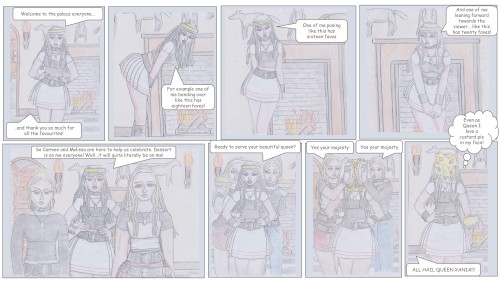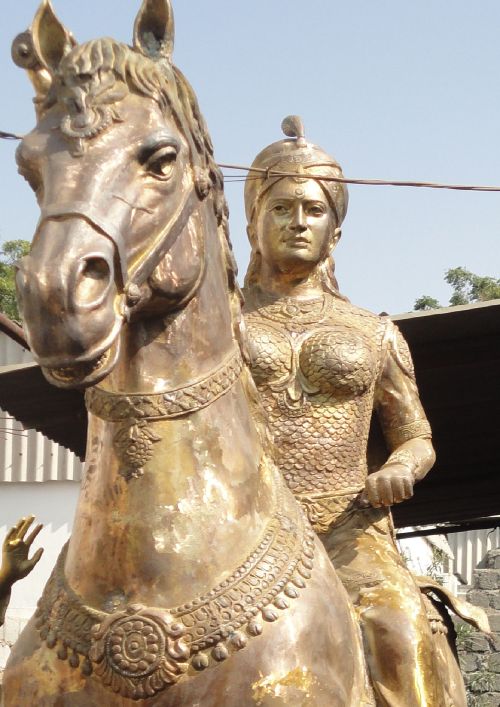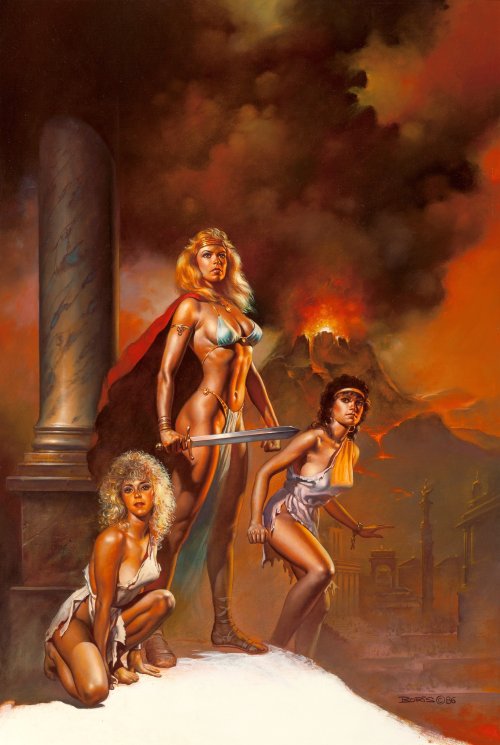#warrior queen
Xania was always going to be on Melissa’s naughty list

Xania has now welcomes everyone to the palace to start some celebrations. She is very happy with all the likes/faves she has received on Deviantart. Hopefully this will get a few likes and, who knows, maybe even some reblogs here on Tumblr. Thank you!
Post link




Huevember day 30 ☘️
Andddddd DONE! 30 women, 30 colors!
I know this is similar to some of the other photos from this set, but I just can’t get enough of warriorqueen!Allison drinking mead and looking dangerous
Post link
Rudrama Devi (1245-1289) was a Warrior Queen of the Kakatiya dynasty in the Deccan Plateau of Southern India.
Rudrama Devi rose to power in 1259 during her early teens when she was appointed co-regent to jointly rule alongside her father, King Ganapati. While Ganapati had no sons, he gave her the male name of Rudra Deva and formally declared her to be his male heir, an image which she did nothing to deter as she dressed in male clothes. She married Veerabadra, a prince of Nidadavolu, with whom she had two female children, but he suffered an early death.
The first few years of Rudrama’s conjoined rule with her father were marred by a Pandya invasion led by Jatavarman Sundara Pandyan I. While the invasion was eventually repelled, the Kakatiyas suffered a number of significant defeats and the kingdom was left in a weakened state. As a result of these failings her father withdrew from public life while passing control to Rudrama, and on his death in 1269 she was officially crowned as Rani (Queen). A number of noblemen, possibly including her own step-brothers, refused to submit to a woman’s authority and rose up in rebellion against her. However Rudrama rallied an army with those nobles and chiefs still loyal to her and successfully crushed the rebellion.
Having secured her kingdom Rudrama spent the rest of her rule defending it from external threats. The Kakatiya were one of four major powers in Southern India who were frequently at war with each other. The Yadava king Maha Deva launched a sustained invasion on the Kakatiya from 1268 to 1270, culminating in a siege of the Kakatiya capital of Orugallu (now Warangal). After 15 days of fighting, an attack led by Rudrama routed the Yadavas and she pursued them in a long retreat back to their own territory during which many Yadavas were captured. Soundly defeated, Maha Deva was forced to pay an enormous ransom for the release of his soldiers. A later invasion by the Odias was also defeated by Rudrama’s generals.
While adept at warfare, Rudrama was also known to have been an effective administrator and when Orugallu was visited by Marco Polo he described her as a lady of discretion who ruled with justice and equity. She also completed work on the Orugallu Fort, adding a second wall and a moat to the structure, which protected the city against numerous future sieges.
In 1280 Rudrama passed the mantle of leadership on to her grandson, Prataprudra, as she was growing old and had no male children of her own. However in 1285 a new threat arose in the form of the Kayastha Chief, Amba Deva, who had allied with the Pandyas and Yadavas to destroy the Kakatiya empire. Though elderly, Rudrama led an army to meet this three-pronged attack head-on, but was killed in the ensuing battle. The Katakiya empire would crumble over the following years, however Rudrama Devi’s legacy is still well remembered in Southern India.
Post link
Artist’s depiction of a Sarmatian warrior
Amage was a Sarmatian warrior queen who lived toward the end of the 2nd Century BCE.
Amage was queen of the Sarmatians, an Iranian people who lived in the western region ofScythia on the coast of the Black Sea. According to the Greek strategist Polyaenus, while Amage’s husband, Medosaccus, was officially the Samartian king, Amage deemed him to be an unworthy ruler who abused his power for personal luxury. She took control of the Sarmatian government and military, using her power to build defensive garrisons which she used to defend her lands on multiple occasions.
Her success as a leader made her famous throughout Scythia and led to the neighbouring Chersonesians to ask for her help when they were being threatened by the Crimean Scythians. Amage agreed to the alliance, sending a message to the Scythian king demanding that he leave the Chersonesians in peace. When the king refused she gathered a force of 120 seasoned warriors, equipping them with 3 horses each so they could cover ground quicky. Marching toward the Scythian palace they covered a distance of more than a 100 stades (180 kilometres) in a single night and a day. The swiftness of the attack caught the Scythian forces off guard and they were easily defeated. Personally leading the assault on the palace, Amage broke into the Scythian king’s quarters and killed him along with his entire family save for one of his sons. She installed the boy as the new Scythian ruler, on the condition that Chersonesus would remain free and that the Scythians would never again attack their neighbours.
While little else is recorded of Amage’s rule, Sarmatian women became known for having a prominent role in war and are recorded by Herodotus as fighting in the same clothing as men. Some believe that the exploits of Amage and similar Sarmatian women served as the inspiration for the Greek myth of the Amazons.
Post link



A fun costume design of Nubia. I really hope to see her portrayed in the DCEU.

Calafia, the Amazonian Queen of the mystical island of California. A fun illustration for a graphic novel I’ve been brainstorming.
Calafia from the Sergas:
“very large in person, the most beautiful of all of them, of blooming years, and in her thoughts desirous of achieving great things, strong of limb and of great courage.
And Candace from the Alexander Romances:
"the whole of her country as ruled by a woman of remarkable beauty, in her early middle age (…) She was above normal human size and almost godlike in appearance."139
Exploring a strange new world, tales of the monstrous and the fabulous, as a type of story these are very old, enduring, and probably take shape across cultures (though I can only speak from my place in the West).
Recently seeing the Movie Oz(….), I was reminded of early European popular fiction, like the Sergas… in the minds of the Conquistadors (see here). This genre and specific set of tales, while notable in the history and naming of California, had previously reminded me of similar figures and tropes in literature preceding the Sergas well into antiquity (see the page tagged Warrior Queens on the side bar).
The tale of Calafia specifically made me recall the tales of Candace (or Kandake) from the Alexander Romances, a genre of tales written continuously in each succeeding age since Alexanders conquests in the 300’s BCE–presumably originating in the recounts of those original soldiers but over the years transforming into the truly fantastic.
The Armenians had preserved a large body these tales (as I am told by The Greek Alexander Romance as translated by Richard Stoneman (penguin classics)). This is where I began seeing the long-scale connections, for the Armenians were subsumed by the Byzantine Empire around 1000 CE, and their diaspora their persisted until the Turkish conquest just before 1500 CE. Their stories and histories no doubt admixed with the Byzantines and when both groups went westward fleeing Ottoman rule, they inspired the revived classicism of the Renascence.
This revival would also inspire the popular press of the day, often over looked by history for their provincial literary merits and skewed renderings of actual events. But it is precisely these stories which inspired the explorers of that age, and perhaps their drive to observe the fantastic, or to marry an amazon or too.
My point in this is that the collection of tales gathered under the ‘Alexander Romances’ are an excellent lens to observe the continuous manifestation of these literary devices, psychological projections on a cultural scale: the self, the other, the strange, the fantastic. And how they very often play out in terms of gender and race (with very real world consequences).
It would be fruitful to study the similarities between the popular Spanish story that introduced the idea of California to the world in such a fantasy, with the recounts of the Alexander romances. Specifically descriptions of places outside the charted world, abundant in gold and jewels, where above normal sized warrior women rule, subject themselves to marring the outsiders, they use magical beasts in combat (in the romances they are sphinxes, in the Sergas they are griffons), and they are governed by a queen who shares a hereditary position and name (in the Sergas its Calafia, in the romances is Candace).
such passages as:
’ Know ye that at the right hand of the Indies there is an island called California, very close to that part of the Terrestrial Paradise, which was inhabited by black women without a single man among them, and they lived in the manner of Amazons. They were robust of body with strong passionate hearts and great virtue. ’ [Sergas de Esplandian, via the wiki commons]
are remarkably similar to those in the romances, where Alexanders army, marching into the unknown world finds lands and islands of resplendent bounty and:
“here dwell the Amazons, who are larger than other races of women and remarkable for their beauty and strength. …They wear silver weapons and axes… they are notable for their intelligence and quick wits”
[the Greek Alexander Romances, Stoneman 146].
**the Silver weapons are similar to the Golden ones the Sergas describes (like the similarity and discrepancy of griffons/sphinxes previously mentioned)
Castaneda is capturing my attention currently, she has a wealth of really articulate and well informed observations. Specifically I will have to bear this passage in mind (where this posts title is found):
Terrorism, militarism, and war masculinize the world, irrespective of how many women serve in the military or conduct suicide missions.1 Using gender to justify war in the twentieth century—bombing Afghanistan to “liberate” Afghan women from Afghan men, for example—recodes gendered hierarchies and relations of power that have, since the sixteenth century, sexualized conquest and justified European imperialism. The gender and sexual politics of religious fundamentalism, whether in the name of contemporary Christianity, Islam, or Judaism, continue to reify patriarchal, misogynist, and heterosexist structures of domination worldwide. “Global capitalism,” our postmodern restructured economy, exploits the labor of men, women, and children within gendered and sexed structures of power framed centuries ago. In the “global market place” women and girls of color remain the target of brutal sexual violence and murder, only now in “free trade zones”; are prey to rape by human smugglers and “law enforcement” agents, including border patrols; and are kept captive in homes where they are maids, housekeepers, and nannies in the “domestic economy of service.” The expanding market in “sexual tourism” is a hugely profitable, global phenomenon.
The rapacity of capitalism is well documented, as is the brutality of war, even as both are occluded from public discussion and/or sanitized in public media owned by a few conglomerates. What is not well documented, and what the articles in this volume elucidate, is the inseparability of gendered politics and other politics that produce/reproduce the U.S.-Mexico borderlands to create the issues we live with today: terrorism, war, and imperial hegemony.
Introduction: Gender on the Borderlands
Castañeda, Antonia.
Frontiers: A Journal of Women Studies, Volume 24, Number 2 & 3,
2003, pp. xi-xix (Article)
Published by University of Nebraska Press
Soldiers, Priests, Convicts (see Starr p47)–the earliest European colonists in California sound like an odd mix and one in tragic lack of estrogen. So when we discuss the position of women in California, especially in the earlier part of this question, what is really being asked about is the lives of specifically Native, Indian Women.
The groups of historians that Castaneda examined are all tinged in their own ways with misguided perspectives based on ego or racisim, and only since the later half of the twentieth century has serious study been undertaken to understand the histories of women and non-Europeans. Kevin Starr himself doesn’t seem to have too much to offer on the role of women in this period, though he does describe on page 47, that there was very little inter-marriage in California, as opposed to the case in other parts of colonial Spain where classes of mixed-race citizens were generated. It is rather telling that a white mans inclusion of women’s history means a detail on marriage.
It was very interesting in the Castaneda article, that while these early historians “fundamentally reflect the political and socio-racial ideology that informed both the war with Mexico and the subsequent socio-political and economic marginalization of Mexicans in California” (p8) what little positive report they did draw upon was from those Euro-Americans that had been to California in the decades before war, as part of those merchants and traders coming to aid the region and diversify society when Spain could not maintain the colony by itself. Starr identifies inter-national marriage in a limited sense, describing how some of these merchants married into the established Spanish-Mexican wealthy families in the days after independence from Spain. However, his description is a rather uninformative list, again dumbly focusing on the issue of marriage [p.59].
After the war the discourse becomes more negative it seems, and its interesting to note the narratives of fantasy of “Spanish-speaking women [who] invited the advances of EuroAmerican men whom they anxiously awaited as their saviors from Mexican men” [Castaneda, p10]. This American type of narrative sounds a lot like those first fantastic tales and romances of Calafia that motivated the first Spanish explorers, even though Starr described this as the heeding of a “medieval mindset” different from contemporary mindsets presumably, but errantly, for here the same theme continued in the minds of Americans in the 19th and 20th century.
The realities for non-white women seems to have changed little from the mission-presidio days, through to its colonization by white Americans. Castaneda says “conquest and racism intensified sexual assault… non-white women could be raped with impunity, just as they could be enslaved, killed, or worked to death.” [p15].
Castañeda, A. I. (1990). Gender, Race, and Culture: Spanish-Mexican Women in the Historiography of Frontier California. Frontiers: A Journal Of Women Studies, (1), 8.









